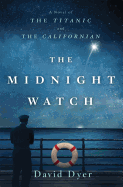
David Dyer's experience as an Australian ship's officer, along with his extensive research into the SS Californian while a maritime lawyer, help to make his first novel, The Midnight Watch, a captivating trip back in time.
On the night of April 14, 1912, Second Officer Herbert Stone stood middle--or midnight--watch on the SS Californian, stopped for the night because of ice conditions in the Atlantic. He observed rockets shot from a nearby ship, and called down to his captain, Stanley Lord. Lord indicated that they could just be company signals; Stone should continue watching. After calling back a second time and sending an apprentice down to update Lord, Stone recorded in the ship's log that the rockets ceased and the lights from the steamer disappeared. What the officer had thought was a steamer that had sailed off was actually the passenger liner RMS Titanic in distress, and it had sunk.
In The Midnight Watch Dyer creates an account of what might have happened on both ships during that fateful night, as told from the perspective of fictional journalist John Steadman. Dyer's compassionate insight into Stone's psyche, with parallel references to Moby-Dick's Starbuck, creates a character almost as empathetic as a family of third-class passengers aboard the Titanic. And the cunningly developed setting is chilling enough to elicit shivers.
With Dyer's skillful writing and nautical understanding, the Titanic's famously tragic story resurfaces a century later, bringing a lesser-known aspect to light in this accomplished novel. --Jen Forbus of Jen's Book Thoughts

